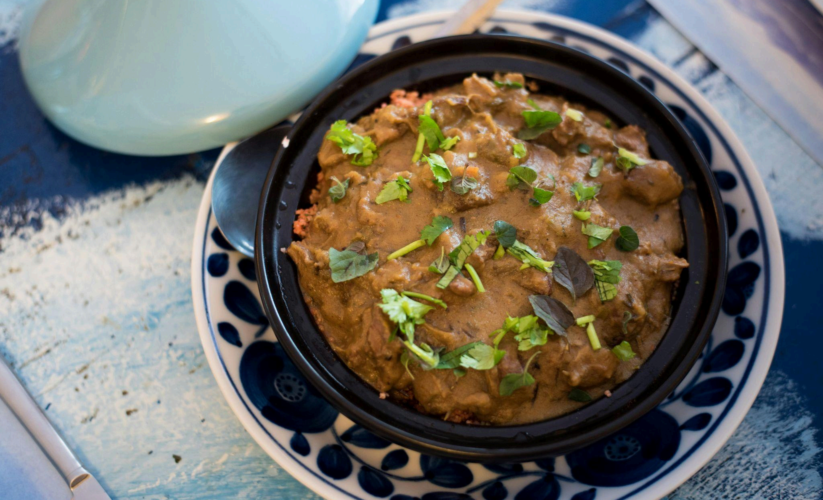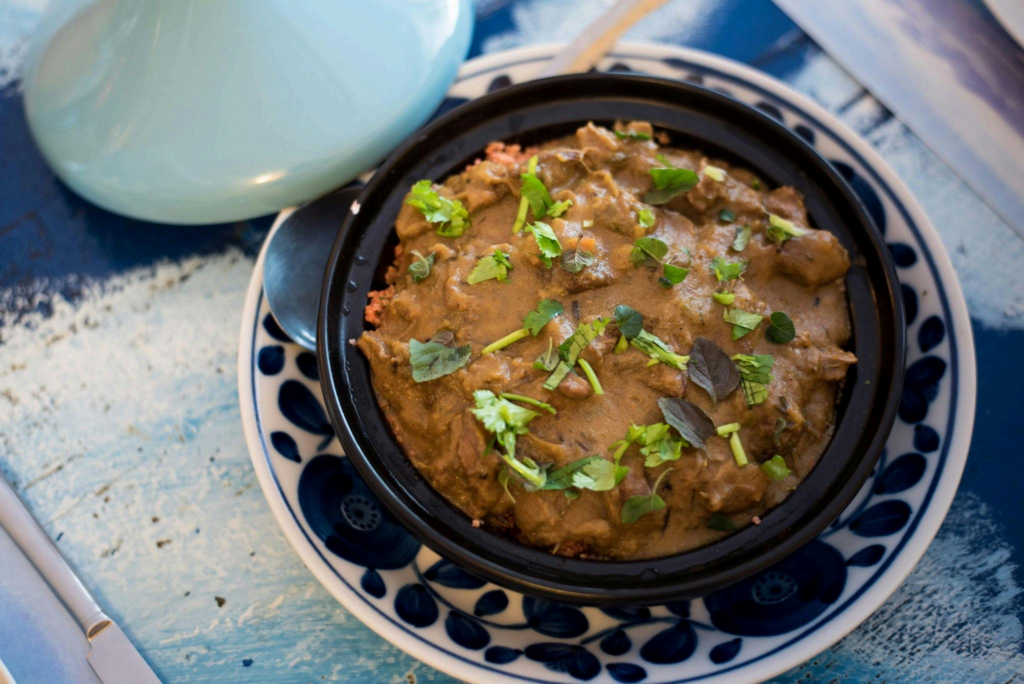
Moroccan Chicken Tagine
(Spiced & Aromatic)
Introduction
Moroccan Chicken Tagine is a hearty, comforting dish that combines succulent chicken
pieces with warm spices, tender vegetables, and a gently simmered sauce. Traditionally
cooked in a tagine (a conical clay pot that helps seal in moisture), this fragrant recipe can
also be prepared in a Dutch oven or a heavy-bottomed pan—making it accessible to home
cooks around the world.
From the heady aromas of spices like cumin, coriander, and ginger, to the sweetness of
dried fruits, Moroccan tagines offer a perfect harmony of sweet and savory notes. Often
served over couscous or accompanied by crusty bread, a tagine meal is as nourishing as it
is flavorful, making it a staple in Moroccan households and a treat for anyone seeking global
culinary adventure.
Why You’ll Love This Recipe
1. Incredible Flavor Fusion: Moroccan cuisine merges sweet and savory elements,
creating layers of taste that captivate the palate.
2. Simple Yet Elegant: Though it sounds exotic, you don’t need specialized equipment
or rare ingredients to achieve an authentic taste.
3. Nutrient-Rich: Loaded with vegetables, spices, and lean protein, this tagine provides
a balanced, healthful meal.
4. Great for Gatherings: The simmering pot of spiced chicken and vegetables is
perfect for entertaining; it perfumes your home with enticing aromas and impresses
your guests.
5. One-Pot Wonder: Everything cooks together in a single vessel, streamlining your
cleanup routine.
Ingredients
Main Components
● 2 pounds (about 900g) bone-in chicken pieces (thighs and legs are preferred for
juiciness; you can also use boneless if you like)
● 2 tablespoons olive oil (plus extra as needed)
● 1 medium onion, finely chopped
● 3 garlic cloves, minced
● 1 cup chicken broth (or water; adjust as needed)Spice Mix
● 1 teaspoon ground cumin
● 1 teaspoon ground coriander
● 1 teaspoon ground ginger
● 1 teaspoon paprika
● ½ teaspoon turmeric
● ½ teaspoon cinnamon (adds sweetness and warmth)
● ¼ teaspoon black pepper (or more, to taste)
● ½ teaspoon salt (adjust later to taste)
Vegetables & Extras
● 2 carrots, peeled and sliced into 1-inch chunks
● 1 cup cubed potatoes or sweet potatoes (roughly 1-inch cubes)
● ½ cup dried apricots (or raisins/prunes), halved if large
● ½ cup pitted green olives (optional, but adds briny contrast)
● 1 tablespoon tomato paste (for added richness)
● 1 tablespoon honey (optional, for extra sweetness)
● Fresh cilantro or parsley, chopped (for garnish)
Serving Suggestions
● Couscous, steamed rice, or crusty bread
● Additional fresh herbs like mint or parsley

Step-by-Step Instructions
Step 1: Prepare & Season the Chicken
1. Pat the Chicken Dry
Use paper towels to remove any excess moisture from the chicken pieces. This helps
them brown better.
2. Combine the Spices
In a small bowl, whisk together cumin, coriander, ginger, paprika, turmeric, cinnamon,
black pepper, and salt.
3. Rub the Chicken
Sprinkle about half of the spice mix over the chicken pieces, coating all sides evenly.
Reserve the rest of the spices for later.
4. Conversation Tip
If you have time, let the chicken rest with the spice rub for 15–30 minutes to deepen
the flavor. You can even marinate it overnight in the fridge.
Step 2: Brown the Chicken1. Heat the Oil
In a tagine pot, Dutch oven, or heavy-bottomed skillet, warm 2 tablespoons of olive
oil over medium-high heat.
2. Sear the Chicken
Place the chicken pieces skin-side down (if using skin-on) and brown for about 4–5
minutes per side. You want a nice golden color.
3. Remove & Set Aside
Transfer the browned chicken to a plate. Don’t worry if it’s not fully cooked at this
point—it will finish cooking in the sauce.
Step 3: Sauté the Onions & Garlic
1. Reduce Heat to Medium
In the same pot (with the flavorful drippings), add chopped onion. Add a bit more oil if
the pot is dry.
2. Cook Until Translucent
Stir for about 4–5 minutes until the onion softens.
3. Add Garlic & Remaining Spices
Stir in minced garlic along with the leftover spice mix. Cook for another minute,
watching carefully so the spices and garlic don’t burn.
Step 4: Build the Sauce
1. Deglaze the Pan
Pour in 1 cup of chicken broth (or water) and use a wooden spoon to scrape up any
browned bits from the bottom. This step infuses the sauce with rich, caramelized
flavors.
2. Add Tomato Paste & Honey
Stir in the tomato paste, followed by honey if you want a touch more sweetness.
3. Layer in Vegetables & Fruit
Add carrots, potatoes (or sweet potatoes), and dried apricots (or other dried fruits). If
you’re using olives, toss them in now for a salty counterpoint.
Step 5: Simmer the Tagine
1. Return Chicken to the Pot
Nestle the browned chicken pieces among the vegetables in the sauce. Ensure
they’re partially submerged for even cooking.
2. Cover & Cook
○ On the Stovetop: Reduce heat to low, cover the pot with its lid, and simmer
for 35–45 minutes.
○ In the Oven: Alternatively, you can place the covered pot in a preheated oven
at 350°F (175°C) for about 45 minutes to 1 hour.3. Check Progress
Stir occasionally to prevent sticking, and add a splash more broth or water if the
mixture appears too thick. The chicken is done when it reaches an internal
temperature of 165°F (74°C), or when the meat is tender and easy to pull away from
the bone.
Step 6: Taste & Adjust
1. Season to Your Preference
Sample the sauce and adjust salt, pepper, or sweetness as needed.
2. Optional Finishing Touches
○ Citrus Twist: Some cooks add a squeeze of lemon or a pinch of preserved
lemon for tanginess.
○ Harissa Kick: For extra heat, stir in a teaspoon of harissa paste.
Serving Suggestions
1. Garnish & Serve
Sprinkle chopped cilantro or parsley on top for color and freshness.
2. Choose Your Base
○ Couscous: A classic partner to Moroccan tagines, as it absorbs the fragrant
sauce.
○ Steamed Rice: If couscous is not available, rice works just as well.
○ Crusty Bread: To scoop up every drop of that rich, spiced gravy.
3. Side Dishes
○ Simple Salad: A light tomato or cucumber salad complements the deep
flavors.
○ Roasted Vegetables: If you want more greens, roasted zucchini or eggplant
pair nicely with the spiced sauce.

Meal Prep & Storage Tips
1. Make Ahead
Tagines often taste even better the next day as the flavors meld. Feel free to prepare
it a day in advance, store it, and reheat it.
2. Refrigeration
Cool leftovers completely before transferring them to an airtight container. Store in
the fridge for up to 3–4 days.
3. Freezing
Freeze any leftover tagine for up to 2–3 months. Thaw overnight in the fridge before
reheating.4. Reheating
Warm gently on the stovetop over low heat, adding a bit of water or broth if the sauce
has thickened too much.
Variations & Substitutions
1. Protein Choices
○ Lamb: Moroccan cuisine often uses lamb or goat in tagines. You can
substitute lamb shanks or chunks for a richer flavor; increase cooking time to
ensure the meat is tender.
○ Beef: Chuck roast or stew meat works similarly to lamb, needing a slightly
longer simmer.
○ Vegetarian/Vegan: Use hearty vegetables like chickpeas, squash, zucchini,
and mushrooms. Omit chicken and adjust cooking time accordingly.
2. Sweet vs. Savory
○ More Sweetness: If you love sweet-sour contrasts, add more dried fruit or a
dash of pomegranate molasses.
○ Less Sweet: Omit the honey and reduce the fruit. Enhance savory flavors
with additional spices or a bit of preserved lemon.
3. Spice Profile
○ Add More Heat: Stir in harissa, cayenne pepper, or fresh chilies.
○ Fresh Herbs: In addition to cilantro or parsley, try scattering fresh mint leaves
on top for a burst of brightness.
4. Liquid Alternatives
○ Vegetable Broth: For a lighter sauce or vegetarian versions.
○ Stock Cubes: Dissolve a small piece of a stock cube in water if you don’t
have fresh broth.
Common Questions
Q: Do I need an actual tagine pot for this recipe?
A: Not necessarily. While a traditional tagine pot gives an authentic cooking experience, a
Dutch oven or heavy-bottomed pot with a tight-fitting lid works just as well. The key is to
maintain moisture and let the ingredients simmer.
Q: How do I know when the chicken is done?
A: Chicken should reach an internal temperature of 165°F (74°C). If you don’t have a
thermometer, poke the meat near the bone; the juices should run clear, not pink.
Q: Can I reduce the fat content?
A: Yes. Opt for skinless chicken breasts instead of thighs or drumsticks. Use minimal oil for
browning and skim any excess fat from the sauce before serving.
Q: What if I can’t find some of the spices?
A: Moroccan cuisine is flexible. While the listed spices create the characteristic profile, feelfree to leave out less common ones or substitute them with a pre-made ras el hanout blend if
available.
Q: Is it safe to add raw potatoes and carrots directly into the pot?
A: Yes. The extended simmering time allows them to cook thoroughly. Just ensure you cut
them into similarly sized pieces so they cook evenly.

Conclusion
Moroccan Chicken Tagine offers a culinary journey to North Africa right from the comfort of
your kitchen. It showcases the magic of layering aromatic spices with sweet and savory
elements—producing a dish that’s warming, wholesome, and irresistible. Whether you
choose to serve it with couscous, rice, or crusty bread, you’ll find the meal hearty enough for
a cold night yet exotic enough to transform any ordinary dinner into a special occasion.
The beauty of tagines lies in their versatility. Vary your proteins, experiment with different
vegetables, or adjust the sweetness-to-spice ratio according to your personal preference.
You can even prepare it ahead of time for easy entertaining or meal prep. Regardless of how
you approach it, the fragrant aroma and rich flavors of Moroccan Chicken Tagine will keep
you returning to this dish time and time again.
So gather your favorite spices, pick out fresh produce, and savor the process of
slow-simmering a pot of flavorful comfort. Before you know it, you’ll have a mesmerizing
tagine, perfect for sharing with family, and friends, or simply treating yourself to something
special. Bismillah—enjoy your meal!





